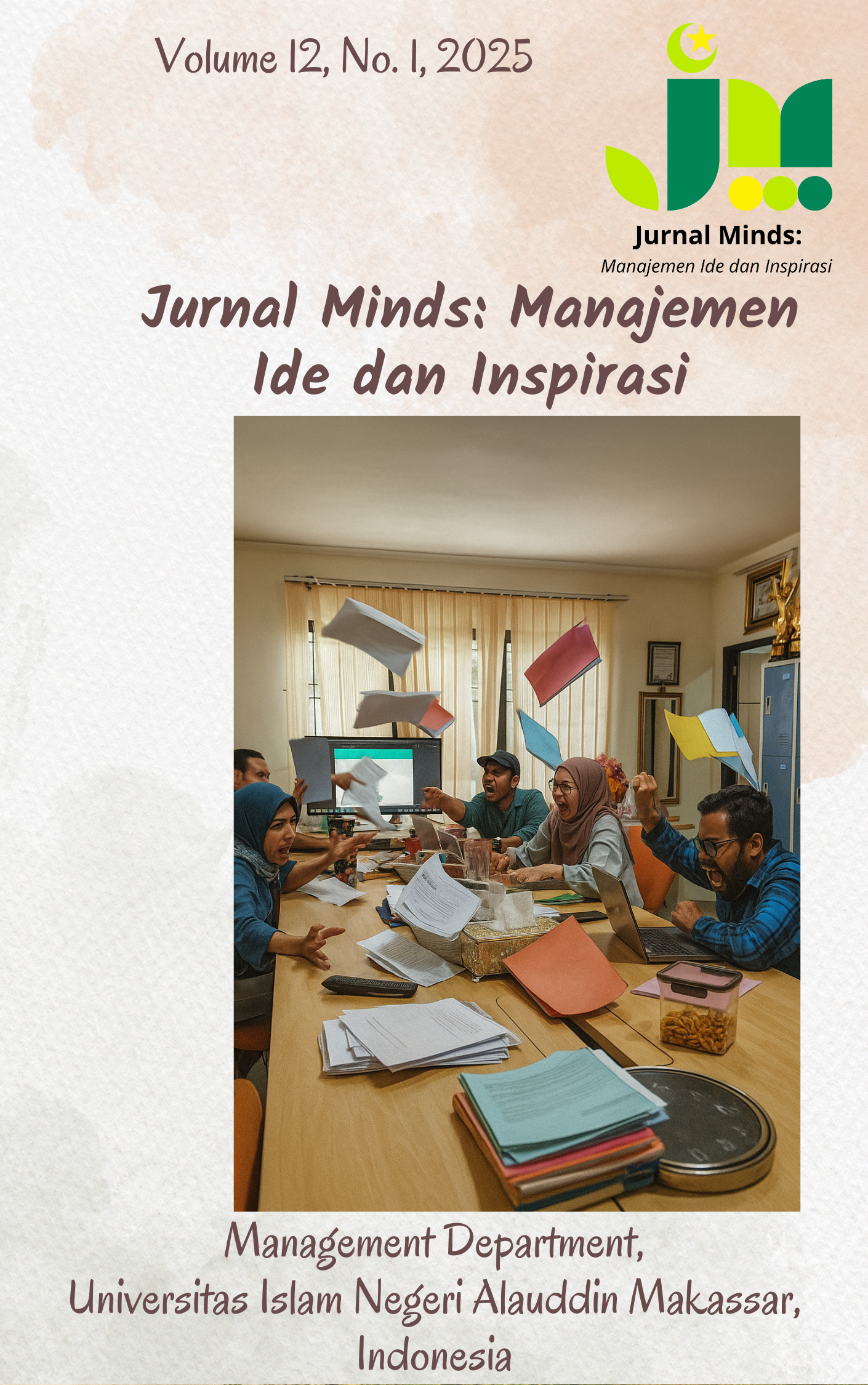Date Log
Copyright (c) 2025 Althof Endawansa, Diahhadi Setyonaluri (Author)

This work is licensed under a Creative Commons Attribution 4.0 International License.
Workforce Inclusion through Training: Evidence from Indonesia’s Disabled Labor Force
Corresponding Author(s) : Althof Endawansa
Jurnal Minds: Manajemen Ide dan Inspirasi,
Vol. 12 No. 1 (2025): June
Abstract
Keywords
Download Citation
Endnote/Zotero/Mendeley (RIS)BibTeX
- Aakvik, A. (2003). Estimating the employment effects of education for disabled workers in Norway. Empirical Economics, 28(3), 515–533.
- Aitken, Z., Bishop, G. M., Disney, G., Emerson, E., & Kavanagh, A. M. (2022). Disability-related inequalities in health and well-being are mediated by barriers to participation faced by people with disability: A causal mediation analysis. Social Science & Medicine, 315, 115500. https://doi.org/10.1016/j.socscimed.2022.115500
- Badan Pusat Statistik. (2021). Survei Angkatan Kerja Nasional. Jakarta: Badan Pusat Statistik.
- Becker, G. S. (1992). Human capital and the economy. Proceedings of the American Philosophical Society, 136(1), 85–92.
- Bell, D., & Heitmueller, A. (2009). The Disability Discrimination Act in the UK: Helping or hindering employment among the disabled? Journal of Health Economics, 28(2), 465–480. https://doi.org/10.1016/j.jhealeco.2008.10.006
- Bellemare, C., Goussé, M., Lacroix, G., & Marchand, S. (2018). Physical disability and labor market discrimination: Evidence from a field experiment. Federal Reserve Bank of St. Louis.
- Borjas, G. J. (2016). Labor economics (7th ed.). McGraw Hill.
- Budría, S., & Telhado-Pereira, P. (2009). The contribution of vocational training to employment, job-related skills and productivity: Evidence from Madeira. International Journal of Training and Development, 13(1), 53–72. https://doi.org/10.1111/j.1468-2419.2008.00315.x
- Chiang, H. M., Cheung, Y. K., Li, H., & Tsai, L. Y. (2013). Factors associated with participation in employment for high school leavers with autism. Journal of Autism and Developmental Disorders, 43(8), 1832–1842. https://doi.org/10.1007/s10803-012-1734-2
- Dalgin, R. S., & Bellini, J. (2008). Invisible disability disclosure in an employment interview: Impact on employers' hiring decisions and views of employability. Rehabilitation Counseling Bulletin, 52(1), 6–15. https://doi.org/10.1177/0034355207311311
- Echarti, N., Schuering, E., & O'Donoghue, C. (2020). Effects of vocational re-training on employment outcomes among persons with disabilities in Germany: A quasi-experiment. Journal of Occupational Rehabilitation, 30(2), 221–234. https://doi.org/10.1007/s10926-019-09866-x
- Flannery, K. B., Yovanoff, P., Benz, M. R., & Kato, M. M. (2008). Improving employment outcomes of individuals with disabilities through short-term postsecondary training. Career Development for Exceptional Individuals, 31(1), 26–36. https://doi.org/10.1177/0885728807313779
References
Aakvik, A. (2003). Estimating the employment effects of education for disabled workers in Norway. Empirical Economics, 28(3), 515–533.
Aitken, Z., Bishop, G. M., Disney, G., Emerson, E., & Kavanagh, A. M. (2022). Disability-related inequalities in health and well-being are mediated by barriers to participation faced by people with disability: A causal mediation analysis. Social Science & Medicine, 315, 115500. https://doi.org/10.1016/j.socscimed.2022.115500
Badan Pusat Statistik. (2021). Survei Angkatan Kerja Nasional. Jakarta: Badan Pusat Statistik.
Becker, G. S. (1992). Human capital and the economy. Proceedings of the American Philosophical Society, 136(1), 85–92.
Bell, D., & Heitmueller, A. (2009). The Disability Discrimination Act in the UK: Helping or hindering employment among the disabled? Journal of Health Economics, 28(2), 465–480. https://doi.org/10.1016/j.jhealeco.2008.10.006
Bellemare, C., Goussé, M., Lacroix, G., & Marchand, S. (2018). Physical disability and labor market discrimination: Evidence from a field experiment. Federal Reserve Bank of St. Louis.
Borjas, G. J. (2016). Labor economics (7th ed.). McGraw Hill.
Budría, S., & Telhado-Pereira, P. (2009). The contribution of vocational training to employment, job-related skills and productivity: Evidence from Madeira. International Journal of Training and Development, 13(1), 53–72. https://doi.org/10.1111/j.1468-2419.2008.00315.x
Chiang, H. M., Cheung, Y. K., Li, H., & Tsai, L. Y. (2013). Factors associated with participation in employment for high school leavers with autism. Journal of Autism and Developmental Disorders, 43(8), 1832–1842. https://doi.org/10.1007/s10803-012-1734-2
Dalgin, R. S., & Bellini, J. (2008). Invisible disability disclosure in an employment interview: Impact on employers' hiring decisions and views of employability. Rehabilitation Counseling Bulletin, 52(1), 6–15. https://doi.org/10.1177/0034355207311311
Echarti, N., Schuering, E., & O'Donoghue, C. (2020). Effects of vocational re-training on employment outcomes among persons with disabilities in Germany: A quasi-experiment. Journal of Occupational Rehabilitation, 30(2), 221–234. https://doi.org/10.1007/s10926-019-09866-x
Flannery, K. B., Yovanoff, P., Benz, M. R., & Kato, M. M. (2008). Improving employment outcomes of individuals with disabilities through short-term postsecondary training. Career Development for Exceptional Individuals, 31(1), 26–36. https://doi.org/10.1177/0885728807313779
